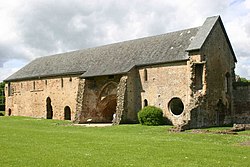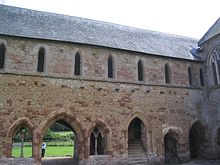Cleeve Abbey
| Cleeve Cistercian Abbey | |
|---|---|
 The dormitory at Cleeve Abbey |
|
| location |
|
| Coordinates: | 51 ° 9 '26.4 " N , 3 ° 21' 49.2" W |
| Serial number according to Janauschek |
519 |
| founding year | 1198 |
| Year of dissolution / annulment |
1536 |
| Mother monastery | Revesby Abbey |
| Primary Abbey | Clairvaux Monastery |
|
Daughter monasteries |
no |
Cleeve Abbey (lat. Abbatia Vallis Florida ) is a former Cistercian - Abbey in England . The monastery is about 3 km southwest of Watchet near Washford in Somerset , near the A39 from Bridgwater to Barnstaple .
history
The monastery was donated between 1186 and 1191 by William de Roumare, whose grandfather William de Roumare had founded Revesby Abbey in Lincolnshire in 1142 , on his estate in Somerset. The Cistercian founding convent, consisting of twelve monks with the first abbot Ralph, came from Revesby Monastery in 1198, a subsidiary of Rievaulx Abbey from the affiliation of Clairvaux Primary Abbey . The foundation was initially opposed by the nearby Cistercians Forde Abbey and Neath Abbey because they were too close. The abbey was called "Vallis Florida" (flowering valley), but remained better known as Cleeve Abbey, which goes back to the nearby village of Old Cleeve. In addition to the foundation through the de Roumare family, the abbey also received donations from other wealthy families in the area; the monastic estates stretched from the Brendon Hills into the Washford River valley and towards the coast and into the Bideford area and as far as Cornwall . The abbey also had the rectorate over the island of Lundy . She also owned several grangia . Towards the end of the 13th century, the number of monks peaked at 28. In the 14th century, a decline began, which led to the end of self-management of the goods. With that, the buildings of the Converses also disappeared in the monastery. Under Abbot David Juyner (1435 to 1487) the situation improved and parts of the monastery were rebuilt, especially a new refectory. Construction was completed under the last abbot, William Dovell. In 1535, the abbey's income was valued at 155 pounds, bringing the abbey under the act of dissolution of 1536. The abolition took place on September 6, 1536. The monastery goods were partly acquired by the Dovell family, the abbey was first loaned to Anthony Busterd for 21 years, but the Earl of Sussex received a little later what was first used as a mansion and then as an agricultural property Land that remained in private hands until 1949 and was only then bought back by the state. After 1870 the monastery became a center of attraction for tourism. English Heritage has looked after Cleeve Abbey since 1984 .
Plant and buildings
The church, the eastern part of which was completed around 1230, corresponded to the original Cistercian plan ("Fontenay type"); it had seven nave bays, a transept with two side chapels on the east side and a rectangular choir. The rest of the enclosure to the right (south) of the church also corresponded to the Bernardine plan. With the exception of the south wall, the church was demolished soon after the monastery was dissolved, the ground plan is still recognizable in the area, and the shafts of individual cylindrical columns have been preserved. The cloister has also been removed, but the east wing of the enclosure (made of local yellow and red sandstone) with a single-nave chapter house and the dormitory on the upper floor are unusually well preserved, while the south wing was thoroughly rebuilt in the 15th century ( refectory with wooden barrel and carved angels now on the first floor and parallel to the cloister, but the floor of the original 19.7 m long refectory standing at right angles to the cloister with its floor tiles has been preserved in situ). Some wall paintings from the late period of the monastery have survived. The west wing (originally the Konversenflügel) was separated from the cloister by a monastery lane (as is often the case with the Filiation of Clairvaux, see e.g. Eberbach Monastery or Neath Abbey ). Various post-medieval parts and walls of the cellar area have been preserved here. The entire complex was restored in 1875/1876. An impressive gatehouse northwest of the monastery has also been preserved.
literature
- R. Gilyard-Beer: Cleeve Abbey, Somerset. 2nd edition. English Heritage, London 1990, ISBN 1-85074-280-4 .
- Stuart A. Harrison: Cleeve Abbey. Somerset. English Heritage, London 2000, ISBN 1-85074-760-1 .
- Anthony New: A guide to the Abbeys of England and Wales. Constable & Company, London 1985, ISBN 0-09-463520-X , p. 114 ff., With a sketch.
- David Robinson (Ed.), The Cistercian Abbeys of Britain. Far from the Concourse of Men. BT Batsford Ltd., London 1998, ISBN 0-7134-8392-X .
